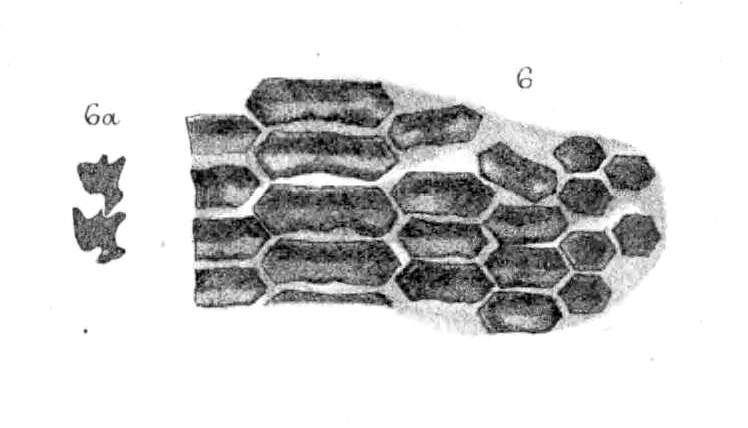Burnhamia davisi
(Woodward, 1889)
Classification: Elasmobranchii Myliobatiformes Mobulidae
Reference of the original description
Catalogue of the fossil fishes in the British Museum. Part. I. British Museum (Natural History): 474 p., fig., 17 pl.
Catalogue of the fossil fishes in the British Museum. Part. I. British Museum (Natural History): 474 p., fig., 17 pl.
Synonyms / new combinations and misspellings
Chomatodus davisi, Chomatodus davisii, Petalodus davisii
Chomatodus davisi, Chomatodus davisii, Petalodus davisii
Description:
Citation: Burnhamia davisi (Woodward, 1889): In: Database of fossil elasmobranch teeth www.shark-references.com, World Wide Web electronic publication, Version 01/2026
Please send your images of "Burnhamia davisi" to info@shark-references.com

Rhinoptera daviesii sp. nov.; portion of dentition, coronal aspect and section. London Clay; Isle of Sheppey. [P. 1514]

Rhinoptera daviesii sp. nov.; portion of dentition, coronal aspect and section. London Clay; Isle of Sheppey. [P. 1514]
Description
Original description of Woodward, 1889 [2593]:
Type. Portion of dentition (PI. III. figs. 6, 6 a); British Museum. Teeth transversely chandelled, arranged in nine antero-posterior series. Each tooth of the median row is about four times as broad as long; the teeth of the first and second lateral rows are also much transversely elongated, being respectively about three and two-and-a-half times as broad as long; the teeth of the two outer rows are slightly broader than long.
Form. & Loc. London Clay (Lower Eocene): Isle of Sheppey.
P. 1514:. Type specimen, generically determined by Mr. William Davies. The fossil consists of a large portion of the dentition with parts of the pterygo-quadrate and mandibular cartilages, embedded in hard clay. The teeth of one jaw are much scattered and displaced, but those of the other are scarcely disturbed, being shown in transverse section surrounding the cartilage, and more than half exposed from above. The upper aspect of the dentition, as far 88 preserved, is shown of the natural size in PI. III. fig. 6; the crowns of the teeth have the appearance of being channeled in the direction of their long axes, and they exhibit a curious mode of interlocking antero-posteriorly, well seen in the transverse fracture (PI. III. fig. 6 a). The dental crown is thin and its lower portion is produced into a projecting ridge anteriorly, which fits into a corresponding groove upon the posterior face of the tooth immediately in front, and is firmly held by a email projecting ledge apparently from the root of that tooth. Such an arrangement has already been described by Agassiz in R. atuderi1• The root exhibits the usual antero-posterior grooves and ridges.
Original description of Woodward, 1889 [2593]:
Type. Portion of dentition (PI. III. figs. 6, 6 a); British Museum. Teeth transversely chandelled, arranged in nine antero-posterior series. Each tooth of the median row is about four times as broad as long; the teeth of the first and second lateral rows are also much transversely elongated, being respectively about three and two-and-a-half times as broad as long; the teeth of the two outer rows are slightly broader than long.
Form. & Loc. London Clay (Lower Eocene): Isle of Sheppey.
P. 1514:. Type specimen, generically determined by Mr. William Davies. The fossil consists of a large portion of the dentition with parts of the pterygo-quadrate and mandibular cartilages, embedded in hard clay. The teeth of one jaw are much scattered and displaced, but those of the other are scarcely disturbed, being shown in transverse section surrounding the cartilage, and more than half exposed from above. The upper aspect of the dentition, as far 88 preserved, is shown of the natural size in PI. III. fig. 6; the crowns of the teeth have the appearance of being channeled in the direction of their long axes, and they exhibit a curious mode of interlocking antero-posteriorly, well seen in the transverse fracture (PI. III. fig. 6 a). The dental crown is thin and its lower portion is produced into a projecting ridge anteriorly, which fits into a corresponding groove upon the posterior face of the tooth immediately in front, and is firmly held by a email projecting ledge apparently from the root of that tooth. Such an arrangement has already been described by Agassiz in R. atuderi1• The root exhibits the usual antero-posterior grooves and ridges.
Remarks
shark-references Species-ID=14485;
shark-references Species-ID=14485;
References
Rise and diversification of chondrichthyans in the Paleozoic. Paleobiology, 50(2), 271–284
DOI: 10.1017/pab.2024.1

Development of understanding of the Mesozoic and Cenozoic chondrichthyan fossil record. Geological Society, London, Special Publications, 430, 155–164
DOI: 10.1144/SP430.4

Handbook of Paleoichthyology, Vol. 3D: Chondrichthyes Paleozoic Elasmobranchii: Teeth Verlag Dr. Friedrich Pfeil, pp. 168, 154 fig., 4 Tab.
Chondrichthyan remains from the Lower Carboniferous of Muhua, southern China. Acta Palaeontologica Polonica, 52(4), 705–727

Systematic relationships of petalodontiform chondrichthyans. In Dutro, J.T. & Pfefferkorn, H.W. (Eds), Neuvième Congrès International de Stratigraphie et de Géologie du Carbonifère. Compte Rendu, 5: 523–541

Catalogue of the fossil fishes in the British Museum. Part. I. British Museum (Natural History): 474 p., fig., 17 pl.
Rise and diversification of chondrichthyans in the Paleozoic. Paleobiology, 50(2), 271–284
DOI: 10.1017/pab.2024.1

Development of understanding of the Mesozoic and Cenozoic chondrichthyan fossil record. Geological Society, London, Special Publications, 430, 155–164
DOI: 10.1144/SP430.4

Handbook of Paleoichthyology, Vol. 3D: Chondrichthyes Paleozoic Elasmobranchii: Teeth Verlag Dr. Friedrich Pfeil, pp. 168, 154 fig., 4 Tab.
Chondrichthyan remains from the Lower Carboniferous of Muhua, southern China. Acta Palaeontologica Polonica, 52(4), 705–727

Systematic relationships of petalodontiform chondrichthyans. In Dutro, J.T. & Pfefferkorn, H.W. (Eds), Neuvième Congrès International de Stratigraphie et de Géologie du Carbonifère. Compte Rendu, 5: 523–541

Catalogue of the fossil fishes in the British Museum. Part. I. British Museum (Natural History): 474 p., fig., 17 pl.


















